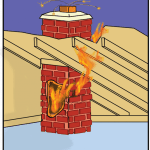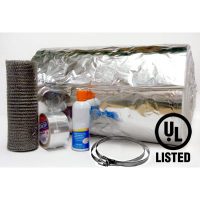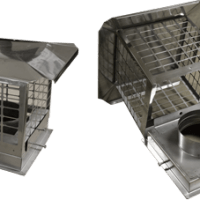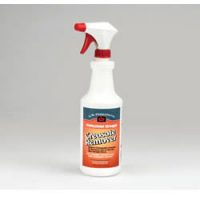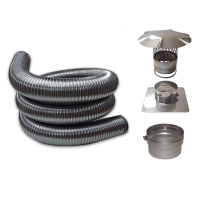Flexible Chimney Flue Pipe can Bring New Life to Your Chimney
The chimney liner is the ultimate solution to the problems that plague most chimneys. Modern stainless steel provides air tight and water tight barrier that seals in gases and creosote. Underwriters Laboratory declared that flex systems excel standards for chimney safety and can even withstand a chimney fire and still maintain structural integrity.
This system is to be installed in all new or existing masonry chimneys that are used for the natural draft venting of gas, liquid, and solid fuel fired residential type appliances and masonry fireplaces. While extreme care has been taken to make the system as safe as possible, proper installation, operation and maintenance should be followed.
316TI Stainless Steel is the Best Stainless Steel for Chimney Liners
316TI is a stainless steel alloy with a small amount of titanium added. It’s make-up allows it to resist acids and the stresses of hot and cold cycles. It can be used with solid fuels (wood, coal and pellet), gas and oil. It can withstand temperatures up to 2100 degrees.
If your masonry chimney is suffering from problems due to a newer appliance, the solution is to install a stainless steel chimney liner.
Stainless Steel Chimney Liner Pipe
What is stainless steel chimney pipe? Most masonry chimneys have a terra-cotta chimney flue liner inside the brick or block exterior of the chimney. Todays appliances can cause serious problems for masonry chimneys. Because of this, stainless steel chimney pipe is used to reline the masonry chimney. This stainless steel chimney pipe provides a protection to the masonry chimney.
Without the stainless steel chimney pipe inside the masonry chimney, there are usually problems. Acidic residue and excessive moisture break down masonry. When this happens cracks can form which can allow toxic gases to enter the home. When deterioration starts taking place in a masonry chimney blockages can form in the chimney. Blockages in a chimney can spell disaster for a home and those who live inside it.
On of the best solutions for a deteriorating chimney flue liner is a stainless steel chimney pipe. Chimney Liner Depot sells the best stainless steel chimney pipes on the market today. Give us a call for assistance with your next chimney relining project. Call now – 1-866-286-1062
Pellet Stove Chimney Liner
 Do pellet stoves need chimney liners? If you have an existing chimney that you would like to vent a pellet stove into you should install a stainless steel chimney liner. Why? In order for an appliance to run correctly it should vent into a chimney or pipe that is sized correctly. Most pellet stoves have 3 inch vent sizes. When installing a chimney liner for a pellet stove there is one thing to remember. If the chimney length is greater than 15 feet you should just up to a 4 inch chimney liner. In this case you will need to go from the 4 inch chimney liner tee down to 3 inch.
Do pellet stoves need chimney liners? If you have an existing chimney that you would like to vent a pellet stove into you should install a stainless steel chimney liner. Why? In order for an appliance to run correctly it should vent into a chimney or pipe that is sized correctly. Most pellet stoves have 3 inch vent sizes. When installing a chimney liner for a pellet stove there is one thing to remember. If the chimney length is greater than 15 feet you should just up to a 4 inch chimney liner. In this case you will need to go from the 4 inch chimney liner tee down to 3 inch.
Oil Furnace Chimney Liner
The incomplete by-product of combustion of fuel oil is unburned carbon & sulfur dioxide simply known as “oil soot”… Oil soot accumulates on the walls and at the base of the chimney, which warrants it be inspected and cleaned annually as suggested in the National Fire Protection Association’s 211-CODE. All though this is not a law, and the code has not been adopted in some states, the code was designated to help homeowners safeguard their home heating unit and contents from “puff-back” which can create an oil mist that settles throughout the home resulting costly professional cleanup.
A big misconception on many homeowners’ part is that the oil service company takes care of the chimney. The oil burner company may shovel out the base of a brick chimney and brush out the connector pipes, but they will not clean the chimney. Most furnace technicians fail to mention anything about the chimney leading homeowners to believe everything is fine. Some oil furnaces service men even tell the homeowner that the chimney is OK without inspecting the entire chimney, which includes going to the roof and inspecting the interior as well as the exterior masonry (if applicable), flashing, chimney cap, etc.
The National Fire Protection Assoc. 211 codes state that “chimneys must be inspected and cleaned as necessary annually” – just like the oil service man services the furnace annually, so should the chimney system be serviced annually. Many homeowners also may not be aware that the chimney’s interior, when not maintained, will decay and break down. For example – just like neglecting your teeth and not having them checked annually may result in cavities. (Or if you don’t change the motor oil in your car for 50,000 miles, you can be sure something in the motor will breakdown.) It’s the same theory with your chimney. As stated earlier, the incomplete by product of combustion is soot, which contains carbon and sulphur. Sulphur, when mixed with rain water (from a missing rain cap) or moisture from the flue gases themselves is absorbed into the flue tile and starts a deteriorating process called flaking or spalling. Just like tartar on your teeth, annual brushing will remove these soot deposits and keep the deterioration process to a minimum.
In metal chimneys the interior lining is made from single-ply or 2-ply stainless steel, which will not rust, but will corrode from the oil soot’s sulfuric acid reaction over time if not cleaned annualy. This corrosion makes small pinholes, which will ruin the integrity of the liner, which will not be able to hold the by-products of combustion. When a clay lining in a masonry chimney flakes or a metal chimney’s insides corrode, they are unable to contain the heat and the flue gases, thus creating a potential fire and health hazard.
Reline your oil furnace chimney flue with the best chimney liner available today. Reline your chimney with a Flex King Chimney Liner. Remember that once a chimney liner is installed in an oil furnace chimney flue, that you must maintain it annually. It still needs to be cleaned even though there is a stainless steel chimney liner installed.
Gas Furnace Chimney Liner
When thinking about a gas furnace and venting it into your chimney you should really consider relining your chimney with a stainless steel chimney liner. Why? Today’s furnaces know how to break down masonry chimneys. It’s what they do. They find ways to make block crumble and create issues for your home. Some will say to reline the chimney with an aluminum chimney liner. You can, but plan on replacing it within 10-15 years. Aluminum chimney liners simply don’t last. If they don’t last they can break down and even create blockages in your chimney. If this happens, the toxic flue gases that are supposed to go outside your home can end up inside. People have died from this, it’s nothing to play games with. If you want the best and safest chimney, reline your chimney with a Flex King Stainless Steel Chimney Liner.
Rigid Chimney Liner
Rigid chimney liner is the best chimney liner you can use. The only thing is you must have a straight masonry chimney flue. If your chimney flue is not straight and has offsets, installing a rigid chimney liner is not your best bet. Most likely you will not be able to install this type of chimney liner. If your chimney has offsets then you will need to use a flexible chimney liner.
Rigid chimney liner is smooth like glass. This will make it so creosote will not stick to the sides of the chimney liner like traditional corrugated flexible chimney liner. Chimney Liner Depot has the best rigid chimney liner available. Give us a call and we will help you figure out if rigid chimney liner will work for your chimney relining project.
Best prices on chimney liners, right now
Right now is the best time to buy chimney liners. Very soon the yearly prices will be going up. It happens every year. Homeowners wait until the last minute to install a chimney liner. Prices are higher during the fall months. Now is the time to start thinking about relining your chimney. Give us a call to discuss your chimney relining project. 1-866-286-1062
It’s hot, but your chimney still exists
Even though it’s hot out, your chimney is still there. Just because it’s not being used doesn’t mean you should ignore the problems that it may have. It’s very possible that you need a chimney liner to help protect the masonry structure from the harsh exhausts from your modern day appliance or stove. A stainless steel chimney liner can make your chimney safe as well as preserve its structural integrity. Chimney Liner Depot offers the industry’s best chimney liners. We carry Flex King and Flex King PRO flexible chimney liners, made from the best quality stainless steel.. Call us today for some great pricing. Remember, there is no better time to buy a chimney liner then right now. The seasonal prices on all our chimney liners will be going up soon.
Call now, 1-866-286-1062
Chimney Repair – Flash Seal
Every chimney is susceptible to water damage. If you have not repaired your chimney yet, the day will come. All chimneys need regular servicing. Chimneys are always outside subject to all the elements. Take a look at this video to see how you can repair the area of the chimney where it goes through the roof.
Chimney Caps
What is a Chimney Cap?
A chimney cap is a protective covering which fits at the top of your chimney enclosure. They are typically fashioned out of stainless steel, copper, or galvanized metals; and come designed with a mesh screen to inhibit airborne hearth sparks, nesting outdoor animals, and damaging precipitation and debris from interfering with the overall safety and longetivity of your fireplace’s necessary venting system.
Why is it so crucial to keep sparks confined to your chimney and these other elements out? While you are toasting marshmallows and sharing intimate discussions by the glow of your fireplace’s hearth, quite a bit more is happening in the venting chamber of your chimney. The sparks produced from burning wood or faux logs will sometimes reach to your chimney’s top, and if not properly stopped, can ignite the flammable material surrounding your chimney wall, such as your roof and house’s construction. And all it takes is one airborne spark. Nesting animals such as squirrels and birds can find a sheltered refuge in your chimney’s top, usually without anyone being the wiser…until it’s too late. A chimney cap prevents them and their detrimental waste from taking up residence, thereby preventing foul odors and the mites that waste brings. Your chimney top is also exposed to rain, snow, hail, and violent gusts of wind; year after year. Without a chimney cap to insulate your chimney from its effects, rain can soak into the mortar joints of your chimney’s construction, thereby loosening the bricks or stone of your masonry chimney. Or if you have a metal chimney, precipitation will lead to damaging rust; thereby rapidly deteriorating your chimney. Violent wind gusts whip leaves and assorted debris into your chimney. These flammable materials can rapidly suffocate your flue from its necessary fire by-product venting, leading to dangerous chimney fires and downdrafting of the trapped smoke into your home. Buying a chimney cap is a priceless and easy solution to preventing a whole Pandora’s Box-full of natural evils, such as: fire, disease, costly repair, and strife from entering the safe harbor of your family’s cozy home.
Types of Chimneys
The first step in finding yourself a chimney cap is determining what type of chimney your house has. This will determine what type of chimney cap will fit best. The most common type of chimney is a masonry chimney, which is constructed of brick, stone, or concrete. Metal Chimneys or factory-built chimneys are mass-produced, typically come with a pre-fit chimney cap, and must be used with one, due to the fact that metal is less resilient in relation to Mother Nature’s elements. Typically, for masonry chimneys, you’ll find that their corresponding chimney caps come in three basic sizes: 8″ x 8″, 8″ x 12″ and 12″ x 12″, though custom styles and fits are available also.
Types of Flues
Whether you have a masonry or factory-made metal chimney, it is also necessary to determine what type of flue it works from. This can be determined by simply looking down into your chimney’s depths.
Masonry chimneys will have either single or multi flues, and these flues will be either extended or not. The most common is the single flue chimney with an extended flue. This flue will simply and visibly extend out the top of your chimney, allowing easy chimney cap installation and fit by screws which tighten to the flue’s construction. Single flue chimneys without extended flues have a recessed interior flue construction and will require what is called a leg kit or bracket to for installation of your chimney cap. The decision about whether you enlist a leg kit or brackets is yours, but brackets are recommended as they provide more resiliency under varying wind and weather conditions. Multi flue chimneys with or without extended flues will, as the type suggests, have more than one flue (typically two) either protruding from your chimney top or recessed in its interior.
Factory-produced Metal Chimney will have one of three basic types of flue construction: double-wall solid-pack insulated chimney pipe, double-wall air-insulated chimney pipe, or triple-wall air-insulated chimney pipe. Looking down into the chimney, you’ll see either two or three layers or walls of metal. If there is a metal cap or insulation material between these layers, you have yourself a solid-pack insulated flue system. If there is nothing but air between your flue walls, it is an air-insulated flue system.
Measuring
After determining what type of chimney and what type of flue you have, the next step is measurement of the flue system. Whether single or multi, extended or recessed, you will almost always need to know the precise width and length dimensions in order to accurately fit your chimney for a cap. Take the measurements a couple times to ensure accuracy, because being just a fraction of a size off, will negate all the purposes you’ve enlisted your chimney cap to demonstrate.
Masonry Chimneys:·For a single flue with an extended flue: measure the width and length of the outside parameters of the flue, and match these to a specific chimney cap size.·For a single flue without an extended flue: measure the width and length of the inside parameters of the flue, match to a specific chimney cap size, and order the corresponding leg kit or brackets.·For multi flue systems with or without extended flues: measure the total outside width and length of the combined flues. If your multi-flue system has one or more extended flues, you must next measure how far the highest flue extends out the top of the chimney. It is crucial when choosing a cap for these systems that you depend upon the measurements of your total flue system, as well as the flues’ height measurements to see how deep your chimney cap should be.
Factory-made Metal Chimneys:·For a double-wall solid-pack insulated flue system: measure the diameter of the inner pipe. Then, measure the diameter of the outer pipe. The inner dimensions will be used to secure the proper fit, while the outer dimensions will give a wider secondary cap protection for your flue. ·For a double or triple-wall air insulated flue system: measure the diameter of the inner pipe. Then, measure the diameter of the outer pipe. The inner dimensions will be used to secure the proper fit, while the outer dimensions will give a wider secondary cap protection for your flue.
Materials
Chimney caps come in a variety of materials depending on your aesthetic, function, and cost preferences. Galvanized metal flue caps are the most cost-effective and simple choice; but provide basic function without regard to aesthetics, will rust, and won’t last past the short-term. Stainless steel chimney cap construction is more middle-of-the-road cost-wise, and subsequently offers a more gratifying visual appeal, and will last much longer through varying elements and time. Copper chimney caps are the most expensive choice, but because of this offer: a hard-enduring quality, can be weathered naturally or coated with a special copper protectant to maintain the original color and shine. Stainless steel and copper constructed chimney caps do, more often than not, come with an extended warranty; and are the best way to go in the way of your chimney’s longetivity and your home and family’s safety.
Chimney Cap Types
Chimney caps also come in a variety of functions according to your cap preferences. There is the standard chimney cap which typically includes a screening material to further ward off elements and critters, is the most cost-effective, comes in a variety of materials, and takes care of your most basic chimney needs as far as insulation and protection is concerned. Draft increasing caps or vacuum chimney caps are more specific to a chimney that has difficulty, for one reason or another, drafting smoke up and out of your home. These chimney caps produce a stronger updraft, and are most often used with metal chimneys, though those with masonry chimneys can employ specific manufacturer adapters. There are two different options to cure this common chimney affliction. You can either employ what is called a flue stretcher which will extend the length of your flue and remove it from the influence of nearby or dual chimneys. This is a great option if you live in a dense city or have multi-floor fireplaces. Another option is a device which will decrease the downdraft by deflecting it within special cap fins, and subsequently suck excessive smoke out of your chimney. You may opt for a cap with an integral damper mechanism to replace a missing or loose-fitting damper system in your chimney. This type of chimney cap, once in place, will cap the previously wasted energy, restore the necessary damper functions, and insulate your home from the elements. Most come complete with a lever you’ll need to install on your fireplace wall, which activates effective use of the damper. Typically, those with older fireplaces will enlist these dual-purpose caps to gently restore an older fireplace.
We have oval, square, and rectangle chimney liner
Our site doesn’t have pricing for oval, square, and rectangle chimney liner. We encourage you to give us a call so we can discuss your chimney relining project with you first. We don’t want to see you order the wrong oval chimney liner. We have the highest quality products and the most competitive pricing in the industry.
Give us a call at 1-866-286-1062 and we will tell you what you need in only a few minutes.
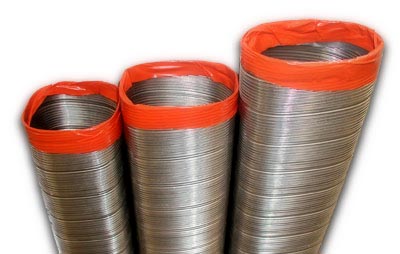
Repairing your chimney crown
If your chimney crown is cracked or looks like this, then you’re chimney system is at great risk for serious water damage. You can have your chimney crown repaired by having the mortar torn off and building a new crown. You also have the option of repairing your chimney crown with a product called Crownseal.
This is a great way to repair your chimney crown and save some money now and long term. If you ignore a chimney crown repair the cost can multiply as the water continues to enter the chimney system.
Click here to view the Crownseal chimney crown repair product in on our online store.
Click here for a video showing how to use Crownseal to repair your chimney crown
DIY Chimney Repair
DON’T LET THIS HAPPEN TO YOUR CHIMNEY!
 Water can make a real mess of your chimney, protect it with ChimneySaver Chimney Water Repellent.
Water can make a real mess of your chimney, protect it with ChimneySaver Chimney Water Repellent.
With good weather here, it’s time to get your chimney clean and in shape.
We want to make sure you use the right tools for the job. Starting immediately, and running through the end of May, 2012, we’ll take 10% off our website prices on ChimneySaver Water Repellent.
NOTICE: This offer is only available to existing customers via phone orders.
Call us at 1-866-286-1062and mention this email.
Click here to access the page for ChimneySaver Chimney Water Repellent.
Chimney Chase Cover
Chimney Chase Cover
Have you noticed over the years a rust colored stain coming from the top of your chimney? This stain is not from your chimney but is in fact from your chase cover.
Where Can I Buy a Chimney Chase Cover?
 Over time almost all pre-fab chimney chase covers rust due to the elements. Snow, ice and rain gets trapped on top of your chase cover and starts the decaying process. Leaves and pine straw also mixed with the moisture creates an acidic condition and breaks down the galvanized coating of your chase cover.
Over time almost all pre-fab chimney chase covers rust due to the elements. Snow, ice and rain gets trapped on top of your chase cover and starts the decaying process. Leaves and pine straw also mixed with the moisture creates an acidic condition and breaks down the galvanized coating of your chase cover.
When this breakdown occurs the chase cover begins to pit. This will allow water to drip inside your chimney. Let this rust stain be your sign that it is time to replace your chase cover.
It is recommended when replacing your chase cover to use stainless steel. Stainless steel is more durable, stronger and will look new for a longer period of time. It is also recommended that the chase cover be designed with a cross break which creates a “dome” effect. This will prevent the snow, ice and water from pooling on top of your chase cover. Stainless chase covers come with a lifetime guarantee against rust and corrosion.
Rigid Chimney Liner
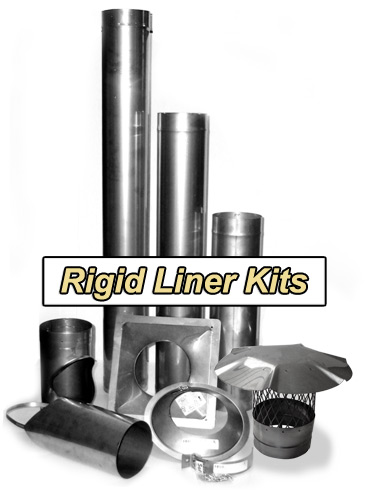
If you are considering relining your chimney with a stainless steel chimney liner, you should definitely consider installing a rigid chimney liner.
304L is for venting wood appliances. 316L is for venting wood, coal, oil, and gas burning appliances.Most rigid chimney liner sections are made of nonmagnetic, series 304L or series 316L stainless steel. Unlike the flexible stainless steel liner, rigid pipe comes in sections and is usually round in shape and one to four feet long and five to ten inches or more in diameter. The most common wall thickness is 24-gauge (0.024 in.) or 22-gauge (0.029 in.) stainless steel.
Stainless Chimney Liners Can Save Lives
Here is a video from our local news station in Northeastern PA. An unfortunate event took place a few weeks ago. A problem with a chimney cost some folks their lives. After an investigation it was determined that an aluminum liner had deteriorated and clogged up the family’s chimney. Carbon Dioxide silently killed 3 people.
Super Fast Chimney Liner Delivery
Since we are located in Pennsylvania, we can offer super fast shipping to all of New England. If you order a chimney liner from most places in New England you can expect in most cases to receive your chimney liner the very next day.

Is it to early to thinking about your heating system?
It’s only the 15th of July, there is plenty of summer left! This is true, but Fall is just around the corner. If you are thinking about relining your chimney, or are planning to utilize your old fireplace by installing a fireplace insert, now is the time to think about a chimney liner.
For some odd reason as humans we like to procrastinate. If it’s summer we don’t like to think about heating our homes. The problem is, when we wait until the last minute things always get complicated. Right now prices are low on chimney liners. As with everything, when demand goes up, prices go up. Stainless steel prices are on the rise as well.

We can’t stress it enough. Now is the time to purchase a chimney liner. Give us a call and we will make the process as simple as possible.
An Overlooked Component
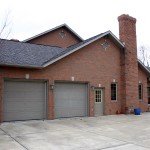
chimney exterior
If you’re like most homeowners, you don’t give much thought to your chimney. Unlike other things like your refrigerator, stove, heating system—it doesn’t make noise and doesn’t seem to require any attention. You may be aware that it needs to be cleaned periodically, but do you know how often? What does a proper, thorough cleaning consist of? Why should you be alert to deterioration, and how does it happen?
Home fires caused by malfunctioning chimneys are a reality. Health threats caused by leaking chimneys emitting dangerous gasses are also a danger. Your family’s safety and indeed their lives may be in jeopardy if you neglect this vital part of your home.
A chimney is not just a brick or stone contraption attached to your house. It has several different components and features that make it function properly. By design, it must be a certain height to provide “draw”. It will usually consist of a fascia, or outside structure that is the part you see. It could be brick or stone, and is designed to compliment your home’s exterior. Inside that fascia, is a liner. The liner is generally terracotta. Terracotta is red ceramic clay that will withstand high heat and is a good material for lining a chimney.
Terracotta liner comes in sections, with mortar between the joints. You may already be starting to understand that so many components can also mean increased potential for deterioration, wear, and ultimately failure of this important system. That’s not good.
You might liken your chimney to your car’s exhaust system. The exhaust system in a car is designed to move the byproduct of combustion out of the engine and safely dispel it into the atmosphere. You are probably aware that your exhaust system is subject to corrosion and in time it fails. You must then replace it. Your chimney does the same thing—it moves the byproducts of combustion out of your heating system and expels them into the atmosphere. A leaking, deteriorated chimney can be a real hazard. Why is that?
The by-products of combustion in your heating system produce smoke. This rises in your chimney and cools as it nears the top. What is also occurring near the top 1/3 of your chimney is very hot air colliding with cold air. This causes condensation. Water from condensation mixing with
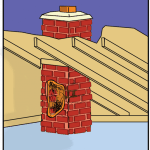
Deterioration of chimney liner
deposits on your chimney wall called creosote will form an acidic substance that eats away at your terracotta and the mortar between the joints. As crumbling and breakage begins to occur, the same condensation starts collecting in the voids. It may freeze and cause more cracking. You should be getting the picture by now.
You can appreciate the dynamics even more if you think of your house as a breathing creature. It may sound strange, but your house is constantly drawing air in and pushing it out. As hot air rises in your building, cold air is being drawn in from below. It will come in through cracks around doors and windows, from the space behind outlets—just about anywhere there’s an opening. Your chimney is doing the same thing. Hot air rising to the top actually creates a “pull”, drawing cold air from the bottom. This pulling action is called draft. Think of drinking from a straw.
So, here you have this constant force pumping air up through your chimney. Condensation is forming. Deposits are sticking to the walls of your liner. It’s becoming acidic and eating into the terracotta and the mortar. Don’t think YOUR heating system is immune—it happens with all heat sources. The end result could be a chimney fire and a house fire.
If you’re using an alternate heat source such as wood, you should be aware that the risk is even greater for creosote build up and deterioration.
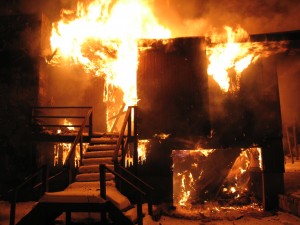
Don't let this happen to your home
Why buy from Chimney Liner Depot?
Here are the top reasons to buy chimney liner from Chimney Liner Depot:
- Best products available
- Industry’s best warranty
- Expert support staff
1. Best products available – We manufacture our chimney liners from the highest quality steels. Our liners have been UL Listed which means they have passed an array of safety tests. When you install a Flex King or Flex King Pro chimney liner you are guaranteed a safe high quality product.
2. Industry’s best warranty – As long as your house is standing your Flex King or Flex King Pro chimney liner will be covered under warranty.
3. Expert support staff – When you call Chimney Liner Depot a support staff is waiting to help you with any tricky installation questions you may have. If you don’t know what you need for your chimney liner installation, call and speak with a member of our support staff. 1-866-286-1062
Home Inpection of a Fireplace
Below are some excellent videos about inspecting your fireplace. Keep in mind Chimney Liner Depot carries a full line of chimney liners for fireplace chimney relining. Give us a call and we can help you determine what size chimney liner you need for your chimney relining job.
Summer Time Chimney Repairs
 Well, it’s just about summer again. You know what that means – hot nights and even hotter days. This time of the year most people are thinking about grilling and having fun. Farthest from their minds is heating their home and the chimney repairs that need to be taken car of before the next heating system.
Well, it’s just about summer again. You know what that means – hot nights and even hotter days. This time of the year most people are thinking about grilling and having fun. Farthest from their minds is heating their home and the chimney repairs that need to be taken car of before the next heating system.
If experience has taught us anything, it’s that during the fall season people are scrambling to get their heating systems up to par for the fast approaching cold season. We know that it’s tough to make repairs when it seems they are not immediately needed, especially in this economy.
That’s why Chimney Liner Depot is offering some really fantastic pricing on our Flex King and Flex King Pro Chimney Liner Systems. Right now we are offering 10% off our already low prices on all of our chimney liners.
Take advantage of our excellent support staff and great low prices. We are there to help make sure you get your chimney relined before it gets cold.


